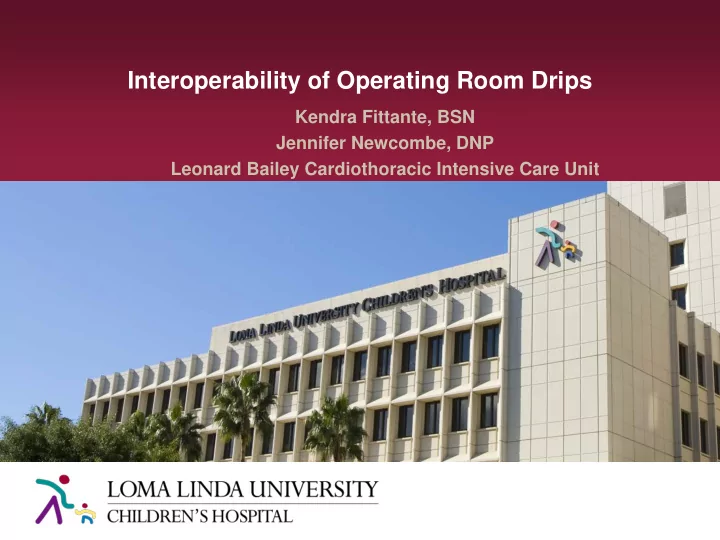

Interoperability of Operating Room Drips Kendra Fittante, BSN Jennifer Newcombe, DNP Leonard Bailey Cardiothoracic Intensive Care Unit
Objectives » Discuss how a multidisciplinary taskforce identified and proposed a solution to fix the interoperability of three EPIC applications: Op time (Operating Room), Willow (Pharmacy) and Clin Doc (Nursing Documentation) in regards to vasoactive medication infusion safety.
Introduction » Medical errors may account for as many as 251,000 deaths annually in the US (Anderson & Abrahamson, 2017) » Medical errors are the third leading cause of death (Anderson & Abrahamson, 2017) » Error rates are higher in the U.S. than in other developed countries such as Canada, Australia, New Zealand, and Germany (Anderson & Abrahamson, 2017) » Bar code scanning is a safe and efficient way to reduce medication errors (Waxlax, 2015)
Background » Loma Linda Electronic Access Portal (LLEAP) is the electronic health record (EHR) system utilized by LLUCH » LLEAP is based on software designed by EPIC » EPIC is a modular system » LLUHS has implemented 20 applications systems ~ Any change in one application model can affect changes within other modules
Identified Problems » Patient arrives to the CVICU with a medication infusing that was started in OR by an anesthesiologist, but concentration and rate ordered by the surgeon are different than what is infusing. » Vasoactive drips made in the OR do not contain a bar code. » Hemodynamic instability of patients during drip changes in the immediate post-operative period. » Nurses were discarding a lot of unused medications, syringes and tubing ~ Inotropic medication cost $20.00 per syringe
Formation of a taskforce » Ryan Lauer, MD » Jenny Chu, Pharm D Pediatric Anesthesiologist CVICU Pharmacist » Jason Gatling, MD » Joanna Robbins, Pharm D Pediatric Anesthesiologist CVICU Pharmacist » Jim Eguchi, MD » Thomas Hatch, Pharm D CVICU Medical Director IT support/Pharmacist » Asma Razavi, MD » Carlos Fierro CVICU Medical Director IT support » Norm Hamada, Pharm D » Kendra Fittante, BSN Director of Clinical Pharmacy CVICU Nurse Educator » Jennifer Newcombe, DNP Cardiothoracic Nurse practitioner
Project Objective » Form a multidisciplinary taskforce that will identify changes in the EPIC build that will allow interoperability of an inotropic agent to be ordered in the OR (OP time), verified by pharmacy (Willow), barcode scanned by the nurse, and documented in the nursing flow sheet (Clin Doc)
Project Design
Project Goals » All inotropic medications made in the operating room will have a bar code » CVICU nurses will be able to document and bar code scan all inotropic medications made in the OR once the patient arrives in the CVICU » Pharmacy will not re-dispense an inotropic medication syringe in order to verify medication made in OR » No inotropic syringe changes made during the immediate post-operative period
Meetings » 1 st meeting January 5, 2016 ~ Process map done from the time an anesthesiologist wrote a vasoactive drip order, to the time patient arrived in CVICU » Met every 2 weeks until April then monthly » Minutes taken and sent to taskforce members not present
Project Methodology
Project Methodology » Tested functionality of the build in the EPIC training environment » EPIC Build finalized March 1, 2016 » Department champions were instructed to train end users in their departments about revised workflow » Nursing staff/Medical CVICU staff trained 3/1/16-3/8/16
Audits
Issues with Implementation » Real time feedback with anesthesia when problem occurred with bar code scanning » New users (i.e. new anesthesia residents, pharmacist) » Educate night pharmacy staff regarding workflow
Results Vasoactive Medications with Bar Code 100 90 80 70 60 50 % of Medications with Bar Code 40 30 20 10 0 1 month 6 months 1 year
Results Bar code scanning rates 100 90 80 70 60 50 Bar code scanning rates 40 30 20 10 0 1 month 6 months 1 year
Results Medication Redispense Rates 100 90 80 70 60 50 Medication Redispense Rates 40 30 20 10 0 1 month 6 months 1 year
Conclusion » Initially walking the process and our interdisciplinary approach was pivotal to the project’s success. » Staff turnover does continue to present challenges, however, real-time communication with all disciplines is very helpful. » Process currently under review after a recent LLEAP upgrade.
References » Anderson, J. & Abrahamson, K. (2017). Your health care may kill you: Medical erros. Stud Health Technol Inform ; 234, 13-17. » Waxlax, T. (2015). Preparing challenging medications for bar code scanning. Am J. Health-Syst Phar ; 72, 1089-1090.
Recommend
More recommend